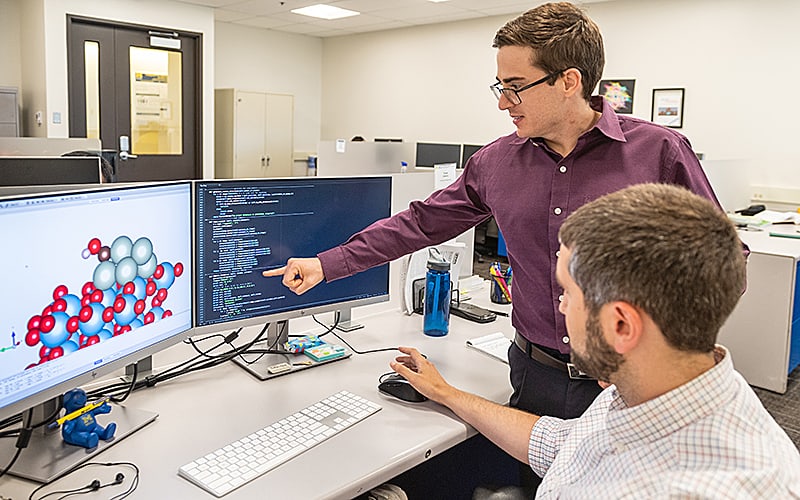Computing and Simulation

Many research groups in our department use advanced scientific computing and molecular simulation as tools for elucidating chemical, physical and biological fundamentals. For example, we are examining the formation and fate of nanoparticles in the environment, chemical reactions occurring on catalyst surfaces, cellular signaling, polymer rheology, low temperature plasmas and nano-scale self assembly of particles with different geometries.
Andrew Allman
Professor Andrew Allman and his research team focus on the development of theory and algorithms which support efficient and optimal decision making (i.e. design, operation and control) for chemical, energy, and biological systems. In particular, our team seeks to develop tools which exploit the structure inherent in such systems in order to quickly solve traditional model-based optimization problems, as well as to identify low-dimensional data subspaces which are most informative towards decision making.
Process Systems Research Team
Sharon Glotzer
Professor Sharon Glotzer and her research group use computer simulation to discover the fundamental principles of how nanoscale building blocks can self-assemble and how that assembly process can be guided to engineer new materials. Her team develops the theory and molecular simulation tools to understand self-assembling, self-sensing, and self-regulating materials. They also model supercooled liquids, glasses, and crystallization processes.
Bryan Goldsmith
Computational modeling of catalysts and materials, and making use of its synergy with experiments, facilitates the process to design new systems since it provides a valuable way to test hypotheses and understand design criteria. Our research team focuses on understanding catalytic systems and advanced materials for use in sustainable chemical production, pollution abatement, and energy generation. To accomplish these goals we utilize and develop various computational tools such as first-principles modeling (e.g., density-functional theory, wave-function based methods, and ab initio thermodynamics), molecular simulation, and data analytics algorithms (e.g., statistical learning and data mining).
Mark Kushner
Professor Mark Kushner and his group develop computationally investigate the fundamental transport and kinetic properties of low temperature plasmas (partially ionized gases), plasma chemistry and plasma surface interactions and their application to society benefiting technologies. Current projects include plasma fabrication of advanced materials for nano-electronics, plasma medicine (use of plasmas for human healthcare), macro- and micro-plasmas as photonic sources, plasmas in liquids, plasma treatment of porous polymeric membranes, and plasma aided combustion for energy efficient transport systems.
Computational Plasma Science and Engineering Group
Ronald Larson
Professor Ronald Larson’s simulation work spans the rheology of polymers, surfactant microstructures, polymer/drug interactions and reconfigurable colloids.
Xiaoxia (Nina) Lin
Professor Nina Lin and her group study biological switching, the symbiotic relationships among communities of microbes and engineering microbial communities process chemicals such as biofuels. Her team uses a combination of experiments and computer modeling.
Rebecca Lindsey
Professor Lindsey’s group develops advanced simulation tools to establish a fundamental understanding of how chemistry mediates material behavior in extreme temperature/pressure environments and in complex systems. Her group leverages this new knowledge for material discovery and design, and to inform development of next-generation materials synthesis and manufacturing methods. Her group specializes in condensed phase simulation spanning quantum mechanical to coarse-grained scales, and artificial intelligence (e.g., machine learning) for efficient simulation and data-driven prediction.
Suljo Linic
The central objective of Professor Suljo Linic’s lab is the development of predictive theories of surface chemistry related to heterogeneous catalysis, electrocatalysis and photocatalysis. Through experiments and theoretical studies, lab members are currently working on a number of projects that aim to address various issues in the fields of energy and environment, functional nanomaterials, industrially-important reactions and fundamental heterogeneous catalysis.
Deepak Nagrath
Nagrath Lab (Systems Biology of Human Diseases)
Greg Thurber
Professor Greg Thurber and his research group study molecules used to image diseased tissue such as tumors, Alzheimer’s plaques and arterial plaques through a combination of experiment and modeling. The same features that allow imaging molecules to target particular tissues can also be turned to targeted drug delivery. With a fundamental understanding of how molecules distribute in the body, the team can design better molecules for imaging and therapies.
Angela Violi
The Violi group uses advanced scientific computing and molecular simulation, including
molecular dynamics, ab initio methods, and machine learning, to investigate fundamental
principles in chemical engineering. Our research spans diverse areas, from nanomaterial
synthesis and characterization to the development of sustainable fuels, with a focus on testing
hypotheses and establishing design criteria for a range of applications.
Robert Ziff
Professor Robert Ziff and his colleagues use computer simulation and mathematical modeling to study a variety of problems of interest to fields of chemical engineering, mathematics, and physics. The modeling and simulation work includes several numerical algorithms to obtain precise critical connectivity thresholds for two and three-dimensional systems through the percolation model. Ziff and his colleagues have also developed a kinetic Monte Carlo technique that allows reaction dynamics to be studied efficiently, including the kinetic phase transitions that occur in such systems.